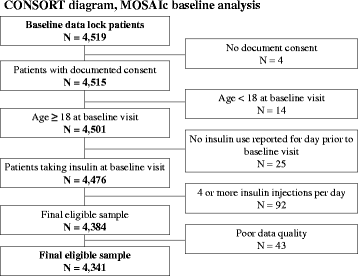Geographic patterns in patient demographics and insulin use in 18 countries, a global perspective from the multinational observational study assessing insulin use: understanding the challenges associated with progression of therapy (MOSAIc)
- PMID: 26353820
- PMCID: PMC4563845
- DOI: 10.1186/s12902-015-0044-z
Geographic patterns in patient demographics and insulin use in 18 countries, a global perspective from the multinational observational study assessing insulin use: understanding the challenges associated with progression of therapy (MOSAIc)
Abstract
Background: Among patients with type 2 diabetes, insulin intensification to achieve glycemic targets occurs less often than clinically indicated. Barriers to intensification are not well understood. We present patients' baseline characteristics from MOSAIc, a study investigating patient-, physician-, and healthcare environment-based factors affecting insulin intensification and subsequent health outcomes.
Methods: MOSAIc is a longitudinal, observational study following patients' diabetes care in 18 countries: United Arab Emirates (UAE), Argentina, Brazil, Canada, China, Germany, India, Israel, Italy, Japan, Mexico, Russia, Saudi Arabia, South Korea, Spain, Turkey, United Kingdom, United States. Eligible patients are age ≥ 18, have type 2 diabetes, and have used insulin for ≥ 3 months with/without other antidiabetic medications. Extensive baseline demographic, clinical, and psychosocial data are collected at baseline and regular intervals during the 24-month follow-up. We conducted descriptive analyses of baseline data.
Results: Four thousand three hundred forty one patients met eligibility criteria. Patients received their type 2 diabetes diagnosis 12 ± 8 years prior to baseline visit, yet patients in developing countries were younger than in developed countries (e.g., UAE, 55 ± 10; Germany = 70 ± 10). Saudi Arabians had the highest HbA1c values (9.0 ± 2.2) and Germany (7.5 ± 1.4) among the lowest. Most patients in 5 (28%) of the 18 countries did not use an oral antidiabetic drug. Over half of patients in fourteen (78 %) countries exclusively used basal insulin; most Indian and Chinese patients exclusively used mixed insulin.
Conclusions: MOSAIc's baseline data highlight differences in patient characteristics across countries. These patterns, along with physician and healthcare environment differences, may contribute to the likelihood of insulin intensification and subsequent clinical outcomes.
Figures
References
-
- Al-Nozha MM, Al-Maatouq MA, Al-Mazrou YY, et al. Diabetes mellitus in Saudi Arabia. Saudi Med J. 2004;25:1603–10. - PubMed
-
- International Diabetes Federation . IDF Diabetes Atlas. Brussels, Belgium: International Diabetes Federation; 2013.
-
- Inzucchi SE, Bergenstal RM, Buse JB, Diamant M, Ferrannini E, Nauck M, et al. Management of Hyperglycemia inType2 Diabetes: A Patient-Centered Approach Position Statement of the American Diabetes Association (ADA) and the European Association for the Study of Diabetes (EASD) Diab Care. 2012;35:1364–79. doi: 10.2337/dc12-0413. - DOI - PMC - PubMed
Publication types
MeSH terms
Substances
Grants and funding
LinkOut - more resources
Full Text Sources
Other Literature Sources
Medical
Miscellaneous


